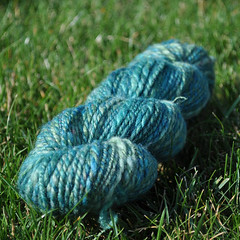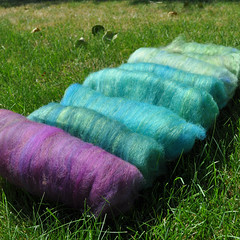Here's just a little taste of the Caribbean, or so I hope. I haven't been there myself, but the color is indelibly inscribed on my psyche by countless cruise promos and posters.
This is the August installment of the Spindler's Monthly challenge, or at least my entry into it. Our theme this go around is "Travel". After almost three weeks of flying solo with the kids, a cruise get-away to the tropics sounds positively dreamy.
I try each Challenge to do something new. This time around, I decided I wanted to spin woolen yarn. And not just semi-woolen yarn, but the best and closest to true woolen yarn I could manage. This means working not from top, but from a carded preparation of fiber, and spinning with the "long draw" technique.
The first challenge was getting carded fiber. Everything I own is what is known as "top" (and is often mis-labeled as "roving"). This is a commercially preparation where all the fibers are combed into alignment in a long strip. Happily for me, the Eugene Textile Center allows drop-in use of its drum carder. For $10 for a half-day, you can card whatever you want (although it did sound as if they wouldn't go for raw fiber, only cleaned materials). I brought in several "cupcakes" of leftover blue wool top, probably merino and BFL. I also included the last ounce of my green silk.
I won't go through all the details of drum carding. There are plenty of other blogs out there written by people with more experience. In short, you break up you fiber into small amounts and feed it into this machine, which blends them together into what is known as a "batt". A batt can be stretched into a roving (a long length of unspun fiber often confused with combed top). Or you can spin it just as it is. Either way, the fibers in a batt are carded, rather than combed, and thus jumbled up a bit. They don't all sit exactly the same way. They cross. They fold. They twist around. This traps in more air and when spun in just the right way, they stay fluffy and soft.
The "long draw" method of spinning involves letting the twist you are introducing into the fiber into your "drafting zone". This distinguishes itself from "short draw", where you inchworm your hands along the fiber, carefully controlling the twist so it only gets into the drafting zone once all the fibers there are carefully aligned with one another, and then you smoooooth it in so there is very little air left in the yarn. This yields a very strong and smooth yarn.
I find long draw to be very challenging. Having freshly drum-carded fiber helped a lot. It was very soft with a lot of air carded into it, instead of having been packed with a lot of other things and squished into a compact lump. It was very easy to draft. On the other hand, I'm a bit of a control freak and letting myself get into the more hands-off groove of long draw is rather tricky. It also drives me nuts that any inconsistency immediately shows up as LUMPS in your yarn.
Still, I managed to toss my ultra control-freak self out the window long enough to finish 110 yards of squishy yarn that probably rates somewhere between aran and bulky in thickness. If you number these batts from back to front, I spun numbers 1-2-4-6 into one single and 3-5-7 into the other (the purple I played with on the side with a tiny leftover of one of my two green singles). So the skein slowly shifts from a very pale ocean green to a deep teal with lots of play through the middle. I think it's going to knit up quite lovely, once I figure out what it ought to be!



No comments:
Post a Comment